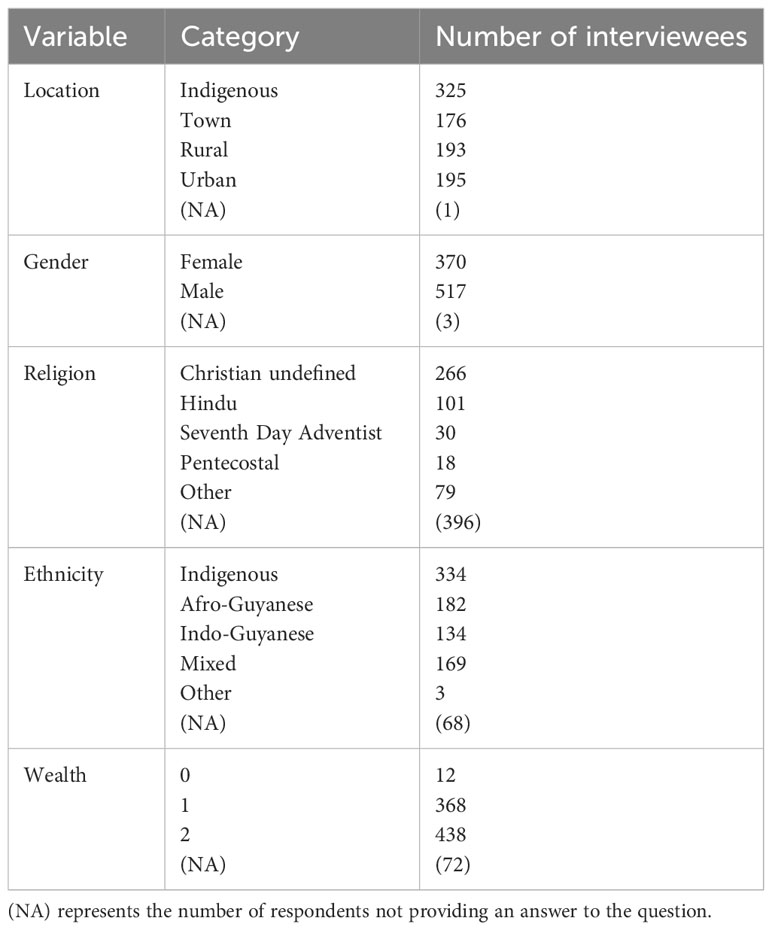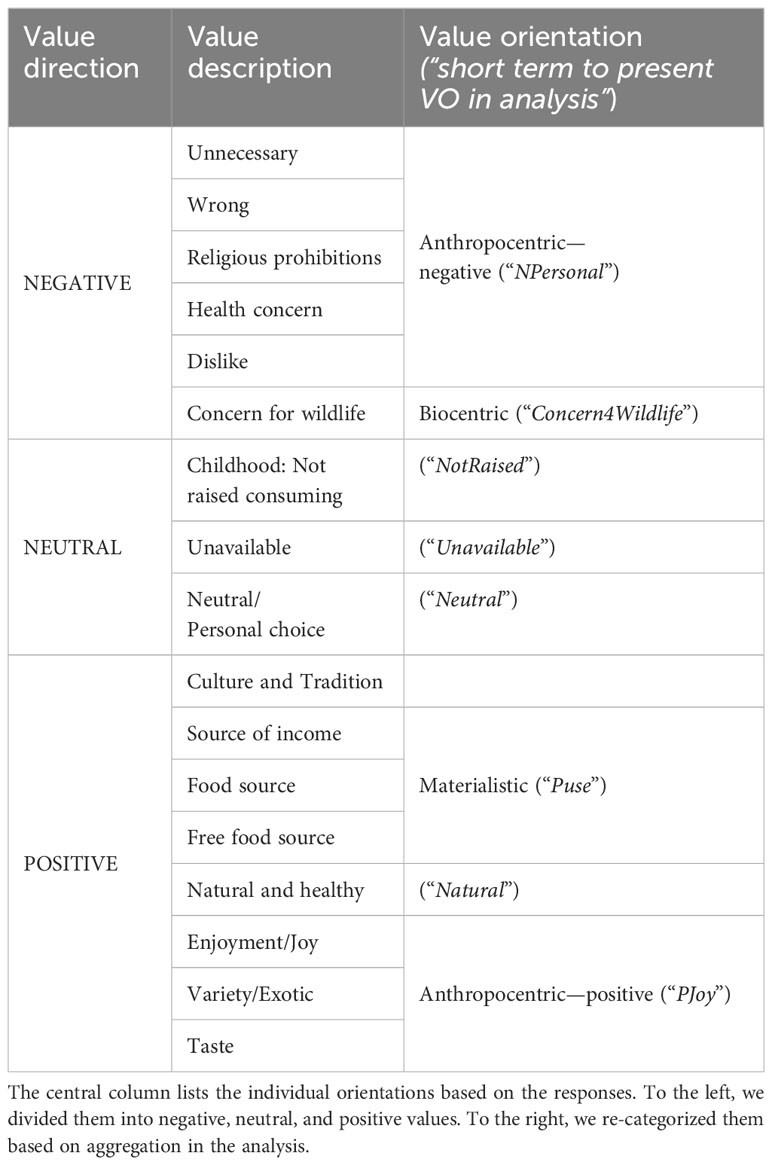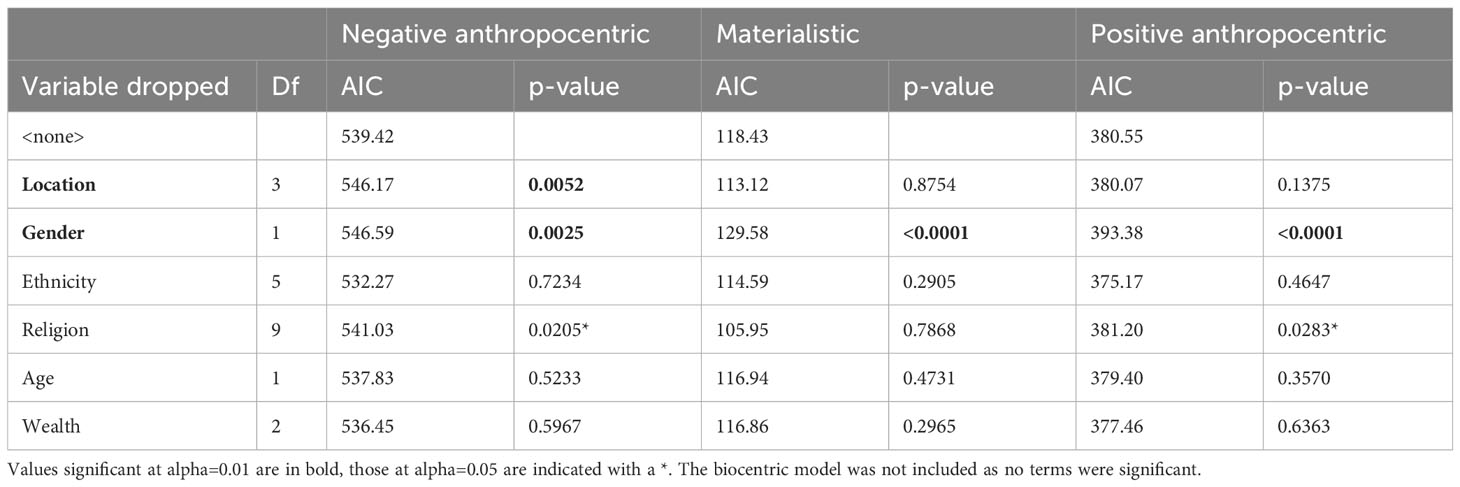- 1Center for International Forestry Research (CIFOR), Jalan CIFOR Situ Gede, Bogor, Indonesia
- 2Iwokrama International Centre for Rainforest Conservation and Development, Georgetown, Guyana
- 3People & Wildlife Solutions, Region 9, Guyana
- 4Guyana Protected Areas Commission, Georgetown, Guyana
- 5South Rupununi District Council, Region 9, Guyana
Introduction: Understanding what drives differences in values toward wild meat is important for developing legislation and behavioral change campaigns that promote sustainable use. Value orientations (VOs) underly behavior. VOs are influenced by personal (e.g., gender, generation), social (e.g., media, family), location (e.g., rural versus urban), and experience determinants. In Guyana, an ethnic diverse nation in South America, the national hunting laws have recently been instated. The wildlife management agency is rolling out a behavioral change campaign in collaboration with a sustainable use initiative. To support this campaign, we evaluated VOs toward wild meat across Guyana.
Methods: Applying Multiple Correspondence Analysis and generalized linear models to data from interviews, we examined location, personal, and societal determinants for their influence on these VOs and explored how VOs translated into behavior, specifically wild meat consumption frequency.
Results: Location (Indigenous and coastal: rural, town, urban), intertwined with ethnicity, and gender showed the strongest associations with variation in VOs. Respondents from Indigenous territories expressed mostly positive VOs compared to coastal Guyanese. Women expressed more neutral or negative, and more negative biocentric VOs compared to men, and this difference was largest among Indigenous but non-existent in urban sites. Negative anthropocentric VOs toward wild meat consistently grouped together and dominated among those not consuming wild meat. Highest consumption was seen among those expressing positive materialistic VOs. Positive anthropocentric VOs were associate with intermediate consumption frequencies and most typical for men. Those expressing negative values toward wild meat based on biocentric orientations toward wildlife consumed wild meat, but rarely.
Discussion: Our results direct behavioral change efforts to men on the coast who consume wild meat for enjoyment at bars, restaurants, or family events. Based on our study, positive messaging promoting the coexistence between consumption of mostly resilient species and caring about wildlife would be well-received to support sustainable use policies.
1 Introduction
The hunting and consumption of species for wild meat are sensitive topics, as this has long been considered to stand in stark contrast with wildlife conservation because it has been a contributor to species declines worldwide (Brashares et al., 2004; Ripple et al., 2016; van Velden et al., 2018). At the same time, wild meat is known to be a healthy food source (Sarti et al., 2015) and continues to be an essential source of nutrition around the globe in communities relying on (partial) subsistence livelihoods due to limited cash income or market access (Bennett, 2002a; De Merode et al., 2004; Chaves et al., 2017; Nunes et al., 2019; van Vliet et al., 2019; Booth et al., 2021). Furthermore, wild meat is also considered an important part of many cultures and traditions, such as among many Amazonian Indigenous Peoples who assign special values to specific species and serve them during celebrations, or urban citizens in Vietnam who use wild meat at social gatherings (Nasi et al., 2011; van Vliet and Mbazza, 2011; Shairp et al., 2016; Chaves et al., 2019; Ingram et al., 2021).
Criminalization of wild meat may therefore not be effective (Davies, 2002; Bennett, 2011; Wilkie et al., 2011), particularly in association with weak enforcement (Parry et al., 2014), and this holds true even if alternative protein sources or alternative livelihoods to commercializing wild meat are available (Baía Júnior et al., 2010; de Melo et al., 2014; Roe et al., 2014; Kiffner et al., 2015). Moreover, it may not be desirable or feasible to end wild meat use in terms of food security or the habitat destruction that would be required to feed those currently living on wild meat (Nunes et al., 2019; Booth et al., 2021). Instead, the wild meat component of wildlife management requires looking beyond livelihoods and considering the full spectrum of values held by consumers, both for legislation and behavioral change campaigns (Manfredo, 2008; Brashares et al., 2014; van Vliet, 2018). Both should aim to develop innovative ways to achieve conservation targets within the existing value system rather than to impose western values (Bennett, 2002b; Rickenbach et al., 2017; van Vliet, 2018) or orchestrate shifts in values, which is a much longer-term process (Manfredo et al., 2017).
Behavioral change campaigns are increasingly incorporated in conservation projects (Drury, 2011; Saypanya et al., 2013; Challender and MacMillan, 2014; Chaves et al., 2018; Wallen and Daut, 2018; Thomas-Walters et al., 2020). By incorporating insights from psychology and marketing, such campaigns can be powerful tools to promote public acceptance of wildlife legislation and management decisions (Toomey, 2023). The success of these campaigns relies in resonating with the values of its audience and different attitudes toward the use of wildlife require different messaging (Thomas-Walters et al., 2021). Furthermore, messaging should target well-defined audience, as among large audience, specific social norms and values are likely to differ (Toomey, 2023).
Value orientations (VOs) are an individual’s interpretation of a set of fundamental values, i.e., a directional pattern in basic values and beliefs. They are good predictors of attitudes, and those in turn predict behavioral intentions (Fulton et al., 1996). Several authors have provided structural approaches to wildlife value orientations (WVOs). They are generally divided into anthropocentric and biocentric WVOs or considered along a continuum of these extremes (Steel et al., 1994; Vaske and Donnelly, 1999). This was thought to be a simplistic view, and people more directly exposed to wildlife are thought to show more diversity in their value orientations (Manfredo and Fulton, 1997). Dayer et al. (2007) categorized WVOs into domination, materialism, concern for safety, scientific, respect, rational, spiritual, mutualism, caring, attraction/interest, and environmentalism, of which the last four could be categorized as biocentric and the others more anthropocentric. These can be applied to various contexts (Rickenbach et al., 2017; van Vliet et al., 2022a). van Vliet et al. (2022a) looked at value orientations toward wild meat in the Democratic Republic of Congo, using the word “nyama” to refer to wild meat. However, as the authors explained, “nyama” also refers to wildlife. As such, in their study, respondents interpreted the word “nyama” as referring to wild meat or wildlife indifferently. VOs toward wild meat (not wildlife), however, can be expected to divert from these categories proposed by Rickenbach et al. (2017) and van Vliet et al. (2022a), as a question on wild meat implies de facto a dead animal used for food or medicine and therefore implies a materialistic connection to wildlife.
VOs are influenced by socio-economic variables at the personal and social level (Manfredo, 2008; Manfredo et al., 2009). Deruiter & Donnelly (2002) proposed a four-dimensional framework of “determinants of value orientations” toward wildlife: (1) socialization (childhood role models, social networks, media, and education), (2) experience (contact with the natural world), (3) personal characteristics (religion, gender, and generation), and (4) place (rural versus urban). Gifford and Nilsson (2014) divided 18 categories into social and personal contexts.
In Guyana, wildlife management legislation has recently been introduced1. The history preceding this first legislation to manage hunting in Guyana is detailed in Paemelaere et al. (2022). The government has now taken an innovative approach by protecting most threatened species from any harm by law while not prohibiting the use of species that are currently commonly consumed, even if globally threatened. Instead, management plans are being developed for these and other commonly traded species to promote sustainable use. With the support of a sustainable use program, the government is developing behavioral change campaigns to support the new wildlife legislation. Here, we present research on wild meat value orientations to underpin these campaigns. Specifically, we looked at value orientations in relation to personal and social contexts and how they associate with wild meat consumption behavior.
2 Methods
2.1 Study site
Guyana is situated in northern South America, between Venezuela, Brazil, and Suriname and bordering the Atlantic Ocean. Its citizens are concentrated in the capital Georgetown and other urban centers, towns, and villages along the coast and consist mainly of people of East-Indian (40%), African (30%), and “mixed” (20%) descent. Caucasian, Latino, and Chinese ethnicities form a minority. The remainder of the country is referred to as “the interior”, which is largely covered in natural habitat of forest and savanna. This area is chiefly inhabited by different Indigenous Peoples (11% of citizens of Guyana) living on titled lands. Indigenous villages included in this study all had access to domestic meat sources through cattle and chicken rearing in the village or market access. Additionally, a few towns have developed to serve the mining and logging concessions, attracting not only citizens from all over Guyana but also foreigners (mostly Asians, some South Americans) contracted by the companies. These diverse ethnicities in Guyana include a wide variety of religions. Most are Hindu (25%) or Pentecostal (23%). Other religions include Anglican, Methodist, Roman Catholic, Jehovah Witness, Seventh Day Adventist, Muslim, and Rastafarian, all constituting between 1% and 6% of the population. Other types of Christians constitute another 20%, and 3% considers themselves atheists (Guyana Bureau of Statistics, 2016). Among Indigenous Peoples, most have converted to one of these religions, although some traditional practices have remained (Luzar and Fragoso, 2013). There are no paved roads in the interior, and a single unpaved road bisects the country and connects the capital Georgetown with Brazil (Figure 1). Other roads serve logging and mining concessions and associated towns.
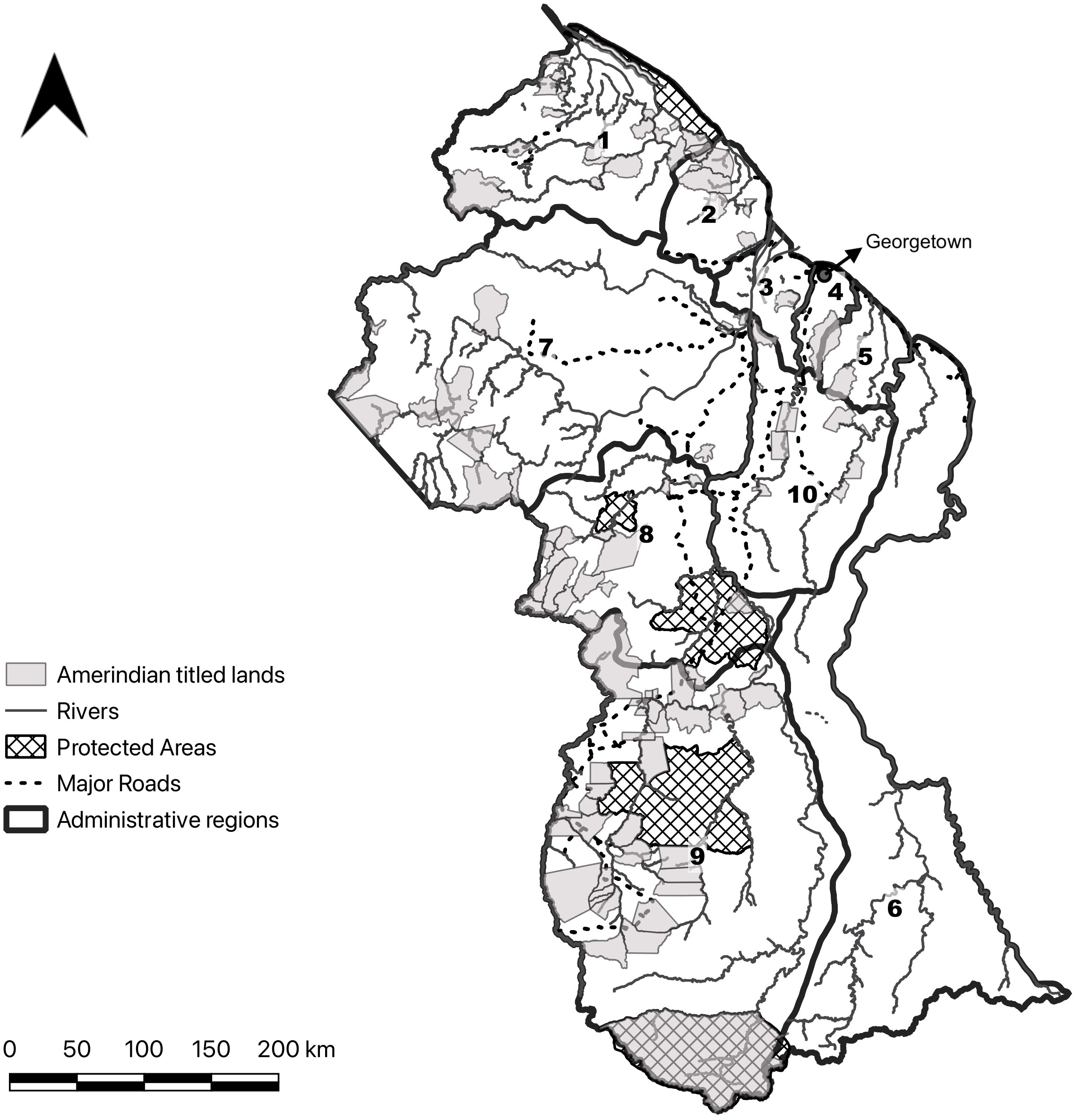
Figure 1 Map of Guyana with its administrative regions by number, Amerindian titled land, protected areas, rivers, and main roads, which are mostly unpaved.
2.2 Data collection and analysis
Between October, 2020 and June, 2021, interviews were conducted across Guyana. The interviews were part of multiple initiatives to understand the use, trade, and livelihood importance of wild meat. The surveys were initially conducted in person. They started in Indigenous villages and an interior town. Within Indigenous territories, households were included based on their presence at the time of the visit and willingness to participate, targeting at least 10% of households. In the town, households were selected on a map on which we had assigned numbers to houses and used a random number generator for selection, also targeting 10%. When all household members were absent at the time of these visits, the household was revisited at a later time. At the start of the second initiative, due to national coronavirus disease, 2019 (COVID-19) restrictions, surveys had to be continued by telephone, for which we also used a random number generator to select phone numbers from the phone directory. The initial number of households selected corresponded with 1% of the households of the locations listed in the directory; however, many could not be reached. The persons conducting the interviews had all received the same training. We have no reason to believe that the medium for conducting the interviews affected the answers. Because wild meat sales and consumption had not been restricted in Guyana and its consumption occurred openly with sign boards at markets and restaurants, wild meat use was not associated with crime, and we had no reason to assume people’s answers would be biased.
To avoid duplicates from the multiple initiatives, we excluded interviews of persons who had previously participated in a similar survey, which was one of the questions. We also excluded interviews where the interviewee had skipped many questions or provided contradicting answers, e.g., stating that they eat meat once a month but wild meat weekly. Interviews of people not permanently residing in Guyana (foreign born or temporary residents) were also excluded. We removed 80 interviews and used a total of 890 surveys from Regions 2, 3, 4, 5, 6, 9, and 10. Regions 1, 7, and 8 could not be reached due to remoteness and limited phone access (Figure 1).
We collected geographic data and demographic data on living location (categorized into urban, town, rural, and Indigenous territory), gender, age, religion, self-identified ethnicity, and wealth (home ownership and motorized transportation availability; Supplementary Table S1). The wealth score ranged from 0 to 2: 0, no ownership of a home or motorized transportation; 1, home ownership or motorized transportation; 2, both home ownership and motorized transportation (Table 1). We asked interviewees about frequency of meat and wild meat consumption, the value they associated with wild meat (VOs), and whether they consumed it or not. Some responses were highly specific, whereas others, such as “dislike”, were broad. Based on a subsample of responses and the description of the value orientations provided by respondents, we built a categorization of VOs into negative, neutral, or positive VOs (Table 2), which reflected the level of attachment to wild meat. Negative value orientations represented dislike for wild meat either because of religion, ethical reasons, concern for health, concern for wildlife, or the believe that consuming wild meat was unnecessary. Neutral VOs expressed no childhood attachment to wildlife or the fact that wild meat was unavailable and not part of their lives. Positive VOs expressed positive appreciation for wild meat in relation to taste, food, health, enjoyment, exotism, culture, and tradition or as source of income. We linked our categorization of VOs toward wild meat to the categorizations of VOs used for wildlife in the available literature (Dayer et al., 2007; van Vliet et al., 2022a) to show that these two categorizations are linked to one another as proposed in Table 2. Additional questions were asked for purposes beyond the scope of this paper, including species consumed. These data are not reported here but available from Paemelaere et al. (2022).
Based on the cognitive hierarchy of behavior (Fulton et al., 1996) and determinants from Deruiter and Donnelly (2002) and Gifford and Nilsson (2014), we considered location and social and personal determinants that could affect VOs and that in turn would affect attitudes and behavior (Figure 2). First, we looked for orientations by combining respondent characteristics with VOs and wild meat use frequency. Next, we explored VOs separately between the characteristics and behavior, respectively.
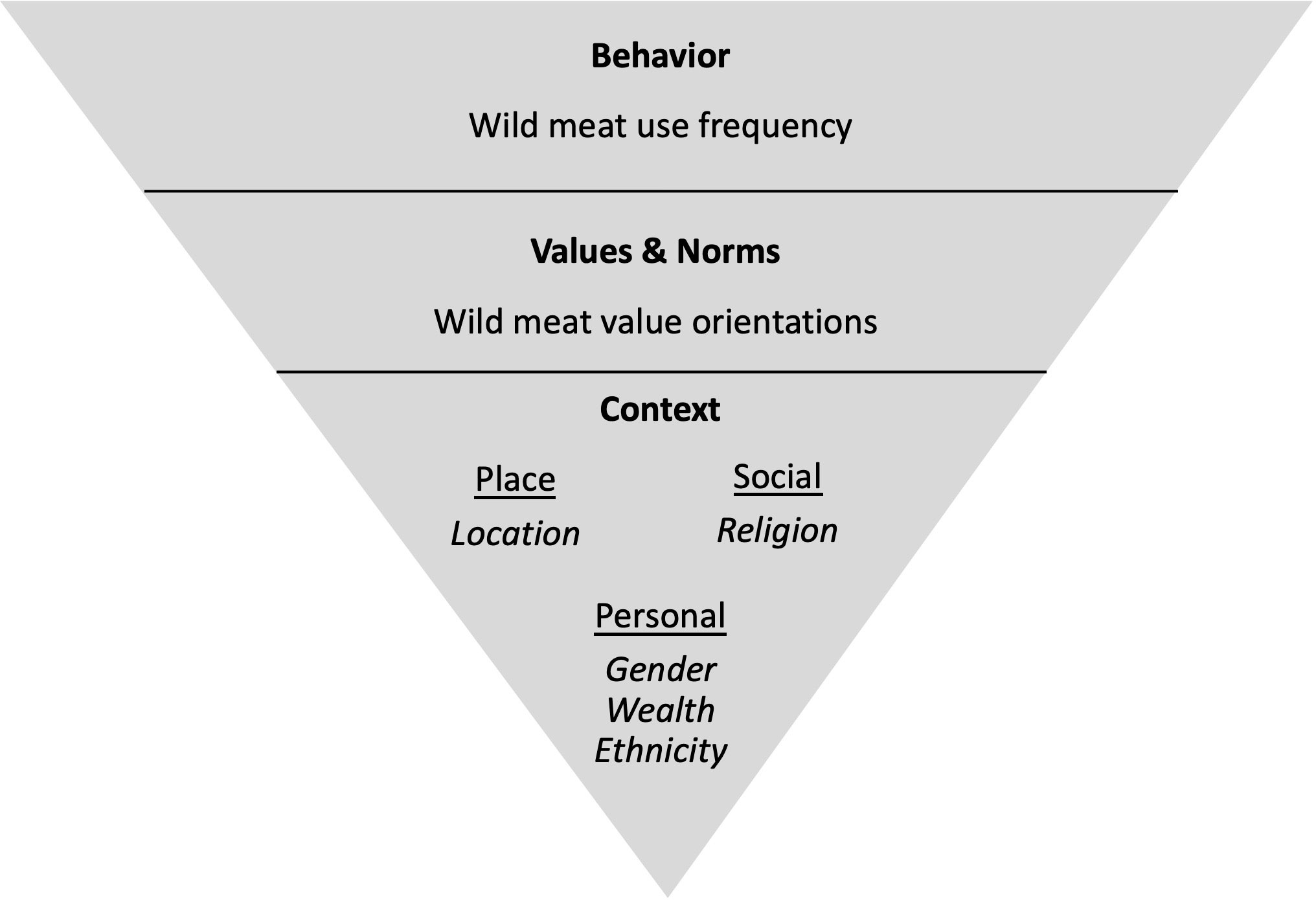
Figure 2 Variables used in the MCA model as adapted from Fulton et al. (1996); Deruiter and Donnelly (2002); Gifford and Nilsson (2014).
All statistics were run in R v.4.2.2 (R Core Team, 2022). We used Multiple Correspondence Analysis (MCA) to explore possible associations between VOs, context variables, and wild meat use frequency in the FactoMineR (Le et al., 2008) and factoextra (Kassambara and Mundt, 2020) packages. We applied a chi-square test to confirm visually associated variables, removing the variables with the lowest contribution to the first two dimensions (closest to the origin of the x- and y-axes). For the negative anthropocentric, negative biocentric, materialistic, and positive anthropocentric value orientations, we also ran generalized linear models with binomial distribution including the variables location, gender, age, wealth, ethnicity, and religion with a stepwise backward selection process using a chi-square test with alpha=0.01. To test for multicollinearity, we used the “vif” function in the package “car” (Fox and Weisberg, 2019).
3 Results
Examples of answers from the respondents and their classification for the VOs are provided in Table 3. Respondents typically related either one or more negative or one or more positive orientations, but 5% were ambivalent in their answers, which in nearly all cases involved being concerned for wildlife in addition to expressing positive VOs. Many felt neutral about wild meat (n=174; 20%). Concern for wildlife was mentioned by 12% of the respondents. Among negative VOs, the general “dislike” was most common; among positive VOs, these were wild meat as a food source and appreciation for its taste.
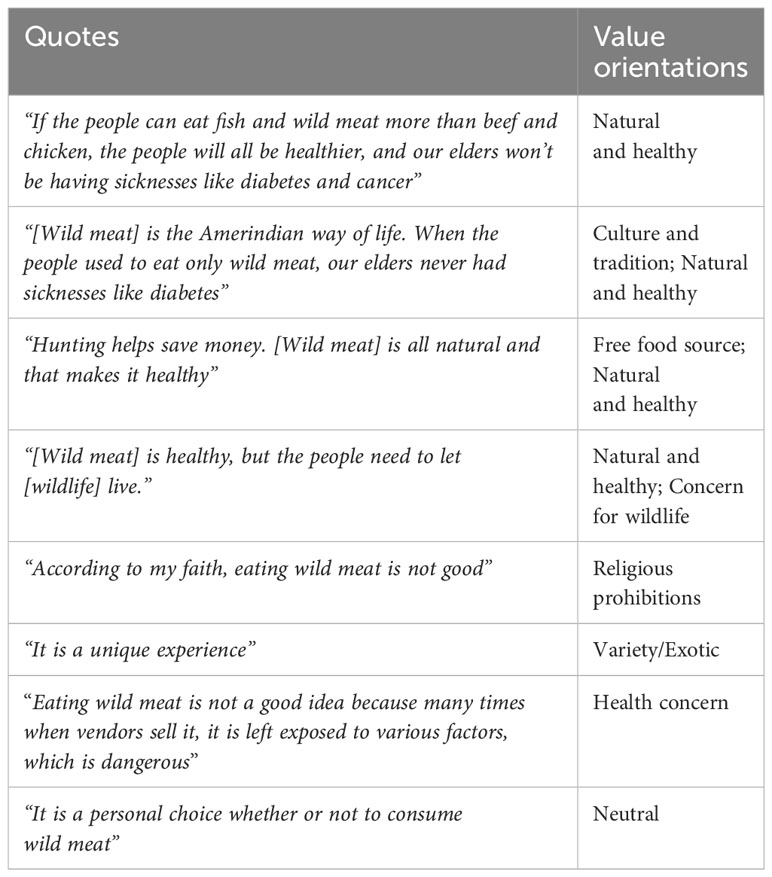
Table 3 Quotes from respondents to the question how they feel about wild meat and their categorization as value orientations.
Wealth did not explain any of the variation and was removed from the variables (v-value: wealth0 = 0.67, wealth1=−3.72, wealth2 = 3.48). Because religion and ethnicity were closely associated [X2(df=65) = 371.73, p < 2.2e−16], we continued with ethnicity alone, as this provided a stronger contribution to the first two dimensions. Furthermore, most Indigenous people lived in Indigenous villages, causing an association between location and ethnicity due to this particular group [X2(df=15) = 879.16, p < 2.2e−16]. We ran the MCA with both variables together and separately. Results were overall the same; the MCA with location and gender resulted in the highest contributions to the variation in the data in the first two dimension.
The MCA with respondent characteristics explained 27.5% of the difference with the first two dimensions (F1 = 17.5%, F1 = 10%). Location contributed the most to this dimension (v-value: Indigenous territory=-25.7, Rural=13.0, Town=8.5, and Urban=8.8), followed by gender (v-value: Male=−22.0 and Female=22.0). Looking at the VOs and wild meat frequency, the first two dimensions MCA explained 23.6% of the variation, and the biggest contrast was found between those never consuming and those consuming (v-value: Never=−24.7, Rare=−0.2, Yearly=7.8, Monthly=12.9, Weekly=10.7, Multiple times a week = 1.7, and Daily=4.0). When we looked at the VOs by combining behavior and respondent characteristics, excluding the respondent characteristics that did not contribute to explaining variation as explained above, the first two dimensions of the MCA explained 24.3% of the variations (Figure 3).
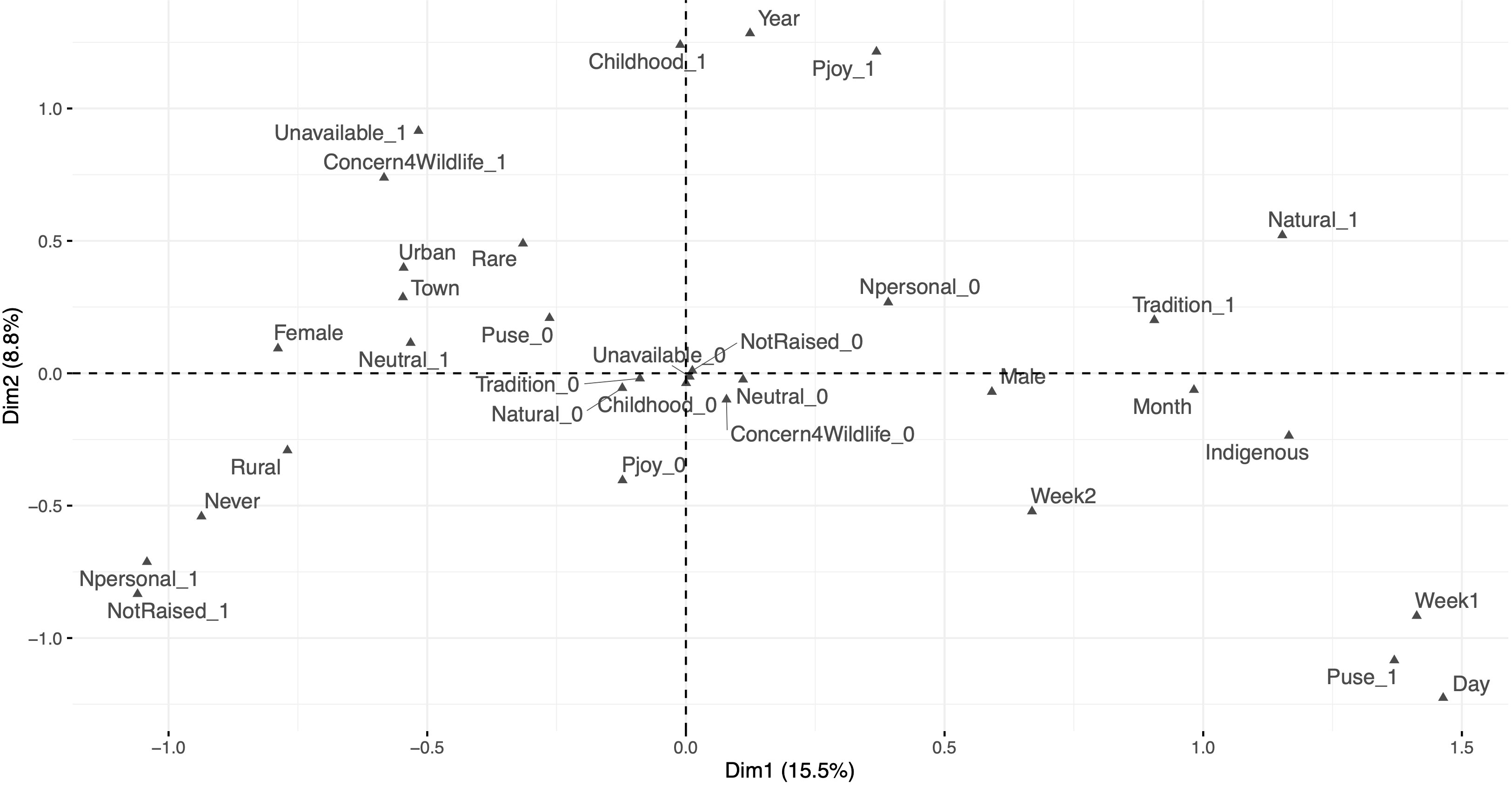
Figure 3 MCA with respondent characteristics, wild meat frequency, and the value orientations. Terms are explained in Table 1.
The linear models showed that negative anthropogenic VOs (Npersonal) were significantly associated with gender and location (Table 4). Women were more likely than men to express these VOs, as were citizens of rural sites compared to those of urban sites. None of the explanatory variables were significant for negative biocentric VOs. Positive materialistic and anthropogenic VOs were both predicted by gender, with men more likely to associate positive VOs with wild meat than women. We plotted the four VOs against the most important explanatory variables gender and location to visualize these results (Figure 4).
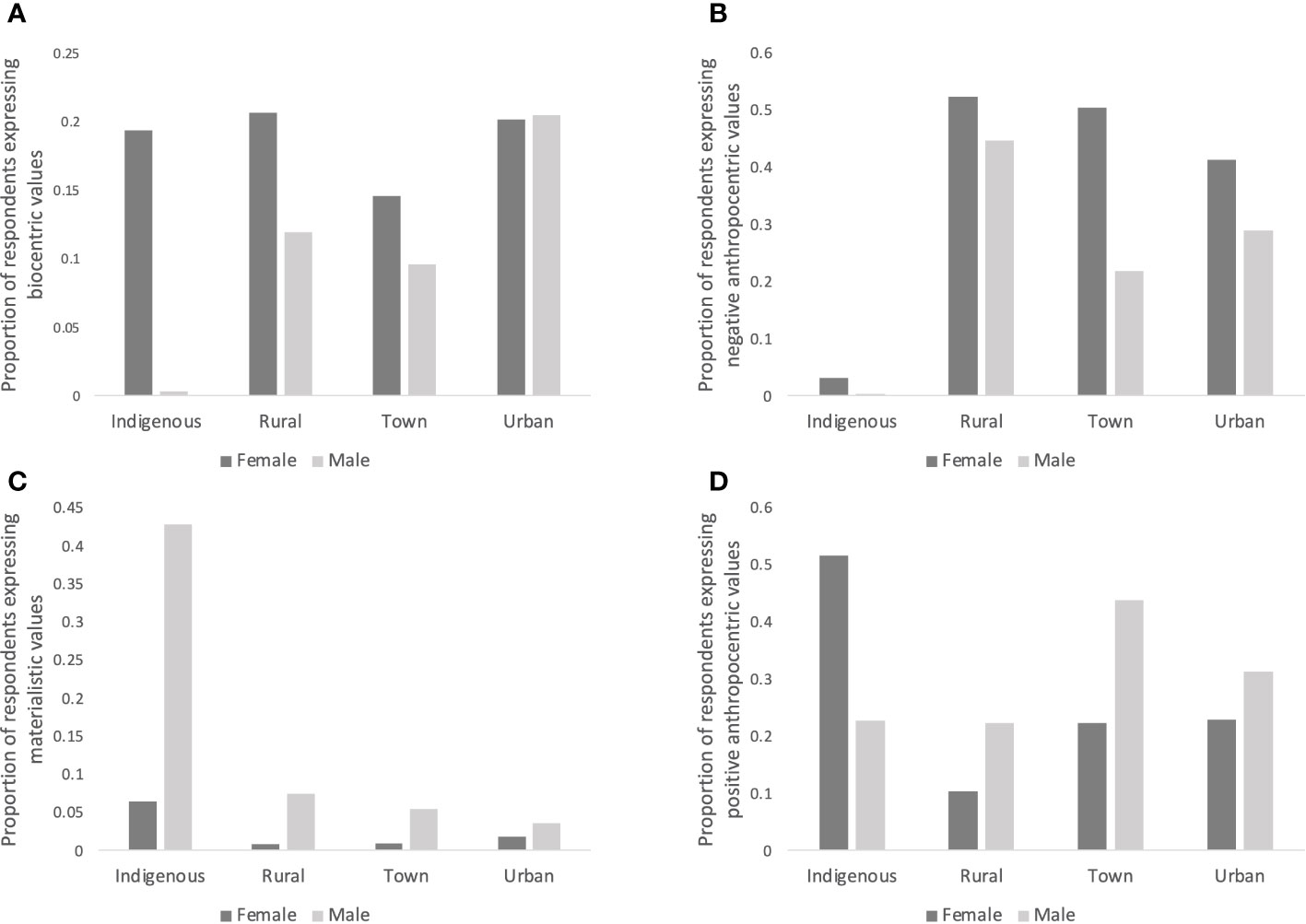
Figure 4 Proportion of respondents per location per gender expressing (A) biocentric values, (B) negative anthropocentric values, (C) materialistic values, and (D) positive anthropocentric values.
4 Discussion
We evaluated wild meat VOs across Guyana, examining location, personal, and societal determinants for their influence on these VOs, and further exploring how the VOs translated into behavior, specifically frequency of wild meat consumption. We detected a very wide range of VOs associated with wild meat, falling into positive, negative, and more neutral appreciations toward wild meat. We found that mostly men and Indigenous People expressed positive VOs, whereas women and rural citizens were more inclined to negative or neutral VOs. A positive materialistic VO associated with a high consumption frequency of wild meat, whereas respondents with other positive VOs consumed wild meat less frequently. Monthly consumption was associated with tradition and considering wild meat to be healthy and natural.
Negative anthropocentric VOs were associated with zero consumption. All VOs of “dislike”, “health concern”, “religious reasons”, “wrong”, and “unnecessary” consistently grouped together, suggesting that there may be a religious undertone to expression of all of these VOs. The reason that religion did not strongly associate with any of these VOs may be because multiple religions prescribe specific food prohibitions (Richards-Greaves, 2013). Further research asking specifically about religious prohibitions and how strictly those are followed would be needed. Although religious prohibitions can have a very strong influence on people’s behavior, in the long term, there is also a risk of erosion of such traditions (Norris and Inglehart, 2011; Luzar et al., 2012).
Positive VOs dominated among the Indigenous, assigning mostly materialistic VOs, tradition, and health. They were also the group with the highest frequency of wild meat consumption. A materialistic VO toward wildlife in general is typically seen among people that depend on it for their livelihood (Inglehart, 1997). Many Indigenous in Guyana still rely on wild meat as part of their livelihoods. Considering that they are a minority in Guyana, this is not a major concern for wildlife, and previous research has shown that hunting by Indigenous Peoples is mostly sustainable (Roopsind et al., 2017; Hallett et al., 2019), although local extinction may occur (Shaffer et al., 2017). This is likely due to the fact that their population size is small compared to the harvest zone, and human population densities of <1 km−2 are generally considered sustainable for subsistence use in tropical forests (Robinson and Bennett, 2000).
Nevertheless, this also included an association with monetary value. Selling of wild meat by the Indigenous in the south of Guyana is mostly done occasionally and may be more common when extra cash is required, e.g., to buy supplies at the start of the school year (Paemelaere et al., 2022). Sales or barter of wild meat by Indigenous Peoples typically occur within the village at prices similar to those of domestic meat sources, which may stem from traditional practices of sharing (Paemelaere et al., 2022). This could in part also be due to the challenges of access to large outside markets (Suárez et al., 2009; Carignano Torres et al., 2022). For Indigenous villages near the coast, however, more market opportunities exist (van Vliet et al., 2022b). Increased market access may reduce Indigenous consumption of wild meat but could also convert wild meat into a valuable good to sell to urban areas (Chaves et al., 2017; Carignano Torres et al., 2022), where the price received would be higher than what is charged within the village. Therefore, for the Indigenous audience, the availability of wildlife friendly livelihoods that can be sustained without external funding (Wicander and Coad, 2015) and promoting both the continued or renewed practice and national recognition of customary law, which promotes sustainable practices, are essential in preventing a damaging impact of the economic potential of wild meat in the future as connectivity between Indigenous and urban centers increases. In Indigenous communities where Customary Law may no longer be highly valued, as may be seen along the coast, additional campaigns to promote sustainable management of wildlife resources and associated sales of wild meat will have to be considered.
There was a clear location effect on positive versus negative VOs. Generally, respondents living in Indigenous territories expressed positive VOs, whereas others leaned toward negative VOs. Furthermore, opposite viewpoints on the health benefits of wild meat showed between the coastal and Indigenous population. Health concerns may be associated with religion, and although particularly Christian religions from the coastal population now also dominate at Indigenous locations, prescribing meat restrictions (Luzar et al., 2012), traditional values of hunting and wild meat may prevail. Differences in interactions with wild meat between Indigenous and coastal citizens may also affect these opposite VOs, as this is refers to the VO determinant “experience” (Manfredo and Fulton, 1997; Deruiter and Donnelly, 2002). Where Indigenous people hunt and process the wild meat within their family unit, coastal citizens obtain the meat mostly from third parties through gifts or purchase (Paemelaere et al., 2022). Wild meat is also not processed in approved facilities, as is the case for beef or chickens, which may further impact people’s perception of the health of wild meat.
Concern for wildlife showed a similar dichotomy; it was associated with the coastal population. The absence of a significant pattern of location context in the linear models may be due to these models omitting all missing values (when a question was not answered), which were more common among Indigenous respondents. Biocentric VOs of wildlife have been found to be stronger among urban compared to rural populations, women versus men, and younger versus older respondents (Kellert and Berry, 1987; Jones and Dunlap, 1992; Steel et al., 1994; Miller and McGee, 2000; Vaske et al., 2001; Rickenbach et al., 2017; van Vliet et al., 2022a). In Guyana, age did not affect any of the VOs. The contrast of more women expressing biocentric VOs was strongest in Indigenous sites and non-existent in the urban environment. Location context has been found to play a role in the gender dichotomy of a more materialistic viewpoint of men versus more biocentric viewpoint of women (Miller and McGee, 2000). Wild meat in Guyana is consumed more frequently by men than by women due to social aspects (Paemelaere et al., 2022). Here, the question arises whether less contact with wildlife and wild meat results in such biocentric value orientation, or vice versa.
Respondents with biocentric VOs still consumed wild meat, although infrequently (rare/yearly). Consuming wild meat and caring about wildlife are thus not mutually exclusive, as has also been seen elsewhere (Nguyen and Jones, 2022; van Vliet et al., 2022a). Holding seemingly contradicting values may also be explained by cultural additivity, where people incorporate values and norms from multiple sources, such as religions or other value systems (Vuong et al., 2018). In this case, the mix of religions, ethnicities with their specific traditions, and growing conservation movements in Guyana may result in such additivity. Moreover, a continuum between anthropocentric and biocentric VOs was already described decades ago (Steel et al., 1994; Vaske and Donnelly, 1999) but appears to have been applied mostly in temperate environments. The finding that wild meat consumption and caring for wildlife can go hand in hand offers a unique opportunity for positive messaging in behavioral change campaigns around wild meat (van Vliet et al., 2022a), with a clear segment of “early adopters” that care about wildlife and may adjust their wild meat consumption accordingly, or would likely do so if the impact of their actions on wildlife is clear.
The group that may consume most of the wild meat on the coast are the ones with positive anthropocentric value orientations. Those associating wild meat with taste, exotic food, unique experience, and general enjoyment were also the group consuming wild meat a few times a year to a few times a month. For the coastal population, this was strongest among men, particularly for towns and urban sites. For Indigenous people, this VOs was expressed more by women, whereas men focused on the materialistic value.
With the coastal citizens being the largest population of Guyana, even when only approximately 60% consumes wild meat and this at a lower frequency compared to the Indigenous (Paemelaere et al., 2022), still an estimated 361 tons of wild meat are consumed annually on the coast (van Vliet et al., 2022b). The top five species consumed also include threatened species, such as tapir (Tapirus terrestris) and white lipped peccary (Tayassu pecari) (Paemelaere et al., 2022; van Vliet et al., 2022b). Such consumption patterns could put species at risk. Similarly, the highest risk of Indigenous contributing to species declines would be through trade to these coastal markets (van Vliet et al., 2022b). Behavioral change campaigns must therefore prioritize the coastal audience.
Specifically, these campaigns must focus on men on the coast who associate it with enjoyment, such as sharing at restaurants and rum shops or at family events. The campaigns should aim to build on messaging that shows coexistence between caring for wildlife and the joy of wild meat, particularly because the notion of sustainability already exists in this society, albeit still limited. Promoting a shift away from sensitive species to more resilient species that are well-liked, such as paca (Cuniculus paca) and deer (Mazama americana) (Parry et al., 2014) while also instilling values of sustainability and maintaining wild meat as an occasional unique experience would be well-received.
Our study showed how VOs can differ greatly across a nation based on personal and social context and go well beyond nutritional needs, emphasizing the importance of research to support behavioral change campaigns targeting a select audience with a specific set of norms and values (Toomey, 2023). Whereas legal frameworks are the same for all citizens, behavioral change campaigns have the opportunity to speak to the public with a consideration for their different values to reach a single goal.
Data availability statement
The raw data supporting the conclusions of this article will be made available by the authors, without undue reservation.
Ethics statement
The studies involving humans were approved by ethics review board – Centre for International Forestry Research. The studies were conducted in accordance with the local legislation and institutional requirements. Written informed consent for participation was not required from the participants or the participants’ legal guardians/next of kin because participants were asked to provide verbal consent after the introduction of the project and before starting the interview. They were also informed that they could end the interview at any time or choose not to answer a question. No names of individuals were recorded (anonymous interviews).
Author contributions
EP: Conceptualization, Data curation, Formal analysis, Funding acquisition, Methodology, Project administration, Supervision, Writing – original draft. AP: Investigation, Methodology, Writing – review & editing. TW: Data curation, Investigation, Methodology, Supervision, Writing – review & editing. GA: Investigation, Methodology, Supervision, Writing – review & editing. MP: Data curation, Formal analysis, Investigation, Writing – review & editing. HY: Investigation, Project administration, Writing – review & editing. AK: Investigation, Writing – review & editing. JZ: Investigation, Writing – review & editing. NV: Conceptualization, Funding acquisition, Methodology, Project administration, Resources, Supervision, Writing – review & editing.
Funding
The author(s) declare financial support was received for the research, authorship, and/or publication of this article. This project was funded by the European Union (GCP/GLO/682/EC) and the Amazon Cooperation Treaty Organization (ACTO; KfW/JH/065/2020).
Acknowledgments
We are grateful to the research assistants and to all the respondents that volunteered their time. This research was carried out as part of the SWM Programme and through an initiative by the Guyana Wildlife Conservation and Management Commission (GWCMC). The SWM Programme is an initiative of the Organisation of African, Caribbean and Pacific States, which is funded by the European Union. The SWM Programme is implemented through a consortium partnership, which includes the Centre for International Forestry Research (CIFOR), the Food and Agriculture Organization of the United Nations (FAO), Wildlife Conservation Society (WCS) and the French Agricultural Research Centre for International Development (CIRAD). The GWCMC initiative was a BioAmazon Project (#2006-66-222) implemented through Iwokrama International Centre for Rainforest Conservation and Development. We obtained permission from the Guyana Environmental Protection Agency: Permit Number, 020521 BR005.
Conflict of interest
The authors declare that the research was conducted in the absence of any commercial or financial relationships that could be construed as a potential conflict of interest.
Publisher’s note
All claims expressed in this article are solely those of the authors and do not necessarily represent those of their affiliated organizations, or those of the publisher, the editors and the reviewers. Any product that may be evaluated in this article, or claim that may be made by its manufacturer, is not guaranteed or endorsed by the publisher.
Supplementary material
The Supplementary Material for this article can be found online at: https://www.frontiersin.org/articles/10.3389/fcosc.2024.1277599/full#supplementary-material
Footnotes
- ^ http://wildlife.gov.gy/wp-content/uploads/2019/08/Wildlife-Conservation-Management-Sustainable-Use-Regulations.pdf
References
Baía Júnior P. C., Guimarães D. A., Le Pendu Y. (2010). Non-legalized commerce in game meat in the Brazilian Amazon: A case study. Rev. Biol. Trop. 58, 1079–1088.
Bennett E. L. (2002a). Is there a link between wild meat and food security? Conserv. Biol. 16, 590–592. doi: 10.1046/j.1523-1739.2002.01637.x
Bennett B. C. (2002b). Forest products and traditional peoples: Economic, biological, and cultural considerations. Nat. Resour. Forum 26, 293–301. doi: 10.1111/1477-8947.00032
Bennett E. L. (2011). Another inconvenient truth: The failure of enforcement systems to save charismatic species. Oryx 45, 476–479. doi: 10.1017/S003060531000178X
Booth H., Clark M., Milner-Gulland E. J., Amponsah-Mensah K., Antunes A. P., Brittain S., et al. (2021). Investigating the risks of removing wild meat from global food systems. Curr. Biol. 31, 1788–1797.e3. doi: 10.1016/j.cub.2021.01.079
Brashares J. S., Abrahms B., Fiorella K. J., Golden C. D., Hojnowski C. E., Marsh R. A., et al. (2014). Wildlife decline and social conflict. Sci. (80-. ). 345, 376–378. doi: 10.1126/science.1256734
Brashares J. S., Arcese P., Sam M. K., Coppolillo P. B., Sinclair A. R. E., Balmford A. (2004). Bushmeat hunting, wildlife declines, and fish supply in West Africa. Sci. (80-. ). 306, 1180–1183. doi: 10.1126/science.1102425
Carignano Torres P., Morsello C., Parry L. (2022). Rural–urban mobility influences wildmeat access and consumption in the Brazilian Amazon. Oryx 56, 1–13. doi: 10.1017/s0030605321001575
Challender D. W. S., MacMillan D. C. (2014). Poaching is more than an enforcement problem. Conserv. Lett. 7, 484–494. doi: 10.1111/conl.12082
Chaves W. A., Monroe M. C., Sieving K. E. (2019). Wild meat trade and consumption in the Central Amazon, Brazil. Hum. Ecol. 47, 733–746. doi: 10.1007/s10745-019-00107-6
Chaves W. A., Valle D. R., Monroe M. C., Wilkie D. S., Sieving K. E., Sadowsky B. (2018). Changing wild meat consumption: An experiment in the central Amazon, Brazil. Conserv. Lett. 11, 352–392. doi: 10.1111/conl.12391
Chaves W. A., Wilkie D. S., Monroe M. C., Sieving K. E. (2017). Market access and wild meat consumption in the central Amazon, Brazil. Biol. Conserv. 212, 240–248. doi: 10.1016/j.biocon.2017.06.013
Davies G. (2002). Bushmeat and international development. Conserv. Biol. 16, 587–589. doi: 10.1046/j.1523-1739.2002.01636.x
Dayer A. A., Stinchfield H. M., Manfredo M. J. (2007). Stories about wildlife: Developing an instrument for identifying wildlife value orientations cross-culturally. Hum. Dimens. Wildl. 12, 307–315. doi: 10.1080/10871200701555410
de Melo R. S., da Silva O. C., Souto A., Alves R. R. N., Schiel N. (2014). The role of mammals in local communities living in conservation areas in the Northeast of Brazil: An ethnozoological approach. Trop. Conserv. Sci. 7, 423–439. doi: 10.1177/194008291400700305
De Merode E., Homewood K., Cowlishaw G. (2004). The value of bushmeat and other wild foods to rural households living in extreme poverty in Democratic Republic of Congo. Biol. Conserv. 118, 573–581. doi: 10.1016/j.biocon.2003.10.005
Deruiter D. S., Donnelly M. P. (2002). A qualitative approach to measuring determinants of wildlife value orientations. Hum. Dimens. Wildl. 7, 251–271. doi: 10.1080/10871200214754
Drury R. (2011). Hungry for success: Urban consumer demand for wild animal products in Vietnam. Conserv. Soc 9, 247–257. doi: 10.4103/0972-4923.86995
Fox J., Weisberg S. (2019). An R Companion to Applied Regression. 3rd ed. (California: Thousand Oaks).
Fulton D. C., Manfredo M. J., Lipscomb J. (1996). Wildlife value orientations: A conceptual and measurement approach. Hum. Dimens. Wildl. 1, 24–47. doi: 10.1080/10871209609359060
Gifford R., Nilsson A. (2014). Personal and social factors that influence pro-environmental concern and behaviour: A review. Int. J. Psychol. 49, 141–157. doi: 10.1002/ijop.12034
Hallett M. T., Kinahan A. A., McGregor R., Baggallay T., Babb T., Barnabus H., et al. (2019). Impact of low-intensity hunting on game species in and around the Kanuku Mountains Protected Area, Guyana. Front. Ecol. Evol. 7. doi: 10.3389/fevo.2019.00412
Inglehart R. (1997). “The trend towards postmaterialist values continues,” in Citizen Politics in post-industrial societies. Eds. Clark Nichols T., Rempel M. (Westview Press, Boulder and Oxford), 5933.
Ingram D. J., Coad L., Milner-Gulland E. J., Parry L., Wilkie D., Bakarr M. I., et al. (2021). Wild meat Is still on the menu: Progress in wild meat research, policy, and practice from 2002 to 2020. Annu. Rev. Environ. Resour. 46, 221–254. doi: 10.1146/annurev-environ-041020-063132
Jones R. E., Dunlap R. E. (1992). The social bases of environmental concern: have they changed over time? Rural Sociol. 57, 28–47.
Kassambara A., Mundt F. (2020) Factoextra: Extract and visualize the reulsts of multivariate data analyses. R package version 1.0.7. Available at: https://cran.r-project.org/package=factoextra.
Kellert S. R., Berry J. K. (1987). Attitudes, knowledge, and behaviours toward wildlife as affected by gender. Wildl. Soc Bull. 15, 363–371.
Kiffner C., Peters L., Stroming A., Kioko J. (2015). Bushmeat consumption in the Tarangire-Manyara ecosystem, Tanzania. Trop. Conserv. Sci. 8, 318–332. doi: 10.1177/194008291500800204
Le S., Josse J., Husson F. (2008). FactoMineR: an R package for multivariate analysis. J. Stat. Software 25, 1–18. doi: 10.18637/jss.v025.i01
Luzar J. B., Fragoso J. M. V. (2013). Shamanism, christianity and culture change in Amazonia. Hum. Ecol. 41, 299–311. doi: 10.1007/s10745-012-9515-2
Luzar J. B., Silvius K. M., Fragoso J. M. V. (2012). Church affiliation and meat taboos in indigenous communities of Guyanese Amazonia. Hum. Ecol. 40, 833–845. doi: 10.1007/s10745-012-9521-4
Manfredo M. J. (2008). Who cares about wildlife? (New York: Springer). doi: 10.1007/978-0-387-77040-6
Manfredo M. J., Bruskotter J. T., Teel T. L., Fulton D., Schwartz S. H., Arlinghaus R., et al. (2017). Why social values cannot be changed for the sake of conservation. Conserv. Biol. 31, 772–780. doi: 10.1111/cobi.12855
Manfredo M. J., Fulton D. C. (1997). A comparison of wildlife values in Belize and Colorado. Hum. Dimens. Wildl. 2, 62–63. doi: 10.1080/10871209709359096
Manfredo M. J., Teel T. L., Henry K. L. (2009). Linking society and environment: a multilevel model of shiftin wildlife value orientations in the western United States. Soc Sci. Q. 90, 407–427. doi: 10.1111/j.1540-6237.2009.00624.x
Miller K. K., McGee T. K. (2000). Sex differences in values and knowledge of wildlife in victoria, Australia. Hum. Dimens. Wildl. 5, 54–68. doi: 10.1080/10871200009359179
Nasi R., Taber A. B., van Vliet N. (2011). Empty forests, empty stomachs? Bushmeat and livelihoods in the Congo and Amazon Basins. Int. For. Rev. 13, 355–368. doi: 10.1505/146554811798293872
Nguyen M. H., Jones T. E. (2022). Predictors of support for biodiversity loss countermeasure and bushmeat consumption among Vietnamese urban residents. Conserv. Sci. Pract. 4, 1–17. doi: 10.1111/csp2.12822
Norris P., Inglehart R. (2011). Sacred and secular: Religion and politics worldwide. (Cambridge, UK: Cambridge University Press). doi: 10.1017/CBO9780511894862
Nunes A. V., Peres C. A., Constantino P., de A. L., Santos B. A., Fischer E. (2019). Irreplaceable socioeconomic value of wild meat extraction to local food security in rural Amazonia. Biol. Conserv. 236, 171–179. doi: 10.1016/j.biocon.2019.05.010
Paemelaere E. A. D., David O., van Vliet N. (2022). Guyana – Legal, ecological and socio-economic baseline studies to inform sustainable wildlife management. (Rome: FAO, CIFOR, CIRAD and WCS). doi: 10.4060/cc0031en
Parry L., Barlow J., Pereira H. (2014). Wildlife harvest and consumption in Amazonia’s urbanized wilderness. Conserv. Lett. 7, 565–574. doi: 10.1111/conl.12151
R Core Team (2022). R: A language and environment for statistical computing. Vienna, Austria. Available at: https://www.R-project.org/
Richards-Greaves G. (2013). “the intersections of ‘Guyanese food’ and construction of gender, race and nationhood,”. Food Identity Carribbean Ed. H. Garth (Bloomsburry) 75–94.
Rickenbach O., Reyes-García V., Moser G., García C. (2017). What explains wildlife value orientations? A study among Central African forest dwellers. Hum. Ecol. 45, 293–306. doi: 10.1007/s10745-016-9860-7
Ripple W. J., Abernethy K., Betts M. G., Chapron G., Dirzo R., Galetti M., et al. (2016). Bushmeat hunting and extinction risk to the world’s mammals. Open Sci. 3, 160498. doi: 10.1098/rsos.160498
Robinson J. G., Bennett E. L. (2000). ““Carrying capacity limits to sustainable hunting in tropical forests,”,” in Hunting for sustainability in tropical forests. Eds. Robinson J. G., Bennett E. L. (Columbia University Press, New York), 13–30. doi: 10.1016/S0169-5347(00)02081-4
Roe D., Day M., Booker F., Zhou W., Allebone-Webb S., Kümpel N., et al. (2014). Are alternative livelihood projects effective at reducing local threats to specified elements of biodiversity and/or improving or maintaining the conservation status of those elements?: a systematic review protocol. Environ. Evid. 3, 6. doi: 10.1186/2047-2382-3-6
Roopsind A., Caughlin T. T., Sambhu H., Fragoso J. M. V., Putz F. E. (2017). Logging and indigenous hunting impacts on persistence of large Neotropical animals. Biotropica 49, 565–575. doi: 10.1111/btp.12446
Sarti F. M., Adams C., Morsello C., van Vliet N., Schor T., Yagüe B., et al. (2015). Beyond protein intake: Bushmeat as source of micronutrients in the amazon. Ecol. Soc 20 (2), 22. doi: 10.5751/ES-07934-200422
Saypanya S., Hansel T., Johnson A., Bianchessi A., Sadowsky B. (2013). Effectiveness of a social marketing strategy, coupled with law enforcement, to conserve tigers and their prey in Nam Et Phou Louey National Protected Area, Lao People’s Democratic Republic. Conserv. Evid. 10, 57–66.
Shaffer C. A., Milstein M. S., Yukuma C., Marawanaru E., Suse P. (2017). Sustainability and comanagement of subsistence hunting in an indigenous reserve in Guyana. Conserv. Biol. 31, 1119–1131. doi: 10.1111/cobi.12891
Shairp R., Veríssimo D., Fraser I., Challender D., Macmillan D. (2016). Understanding urban demand for wild meat in Vietnam: Implications for conservation actions. PLoS One 11, 1–14. doi: 10.1371/journal.pone.0134787
Steel B. S., List P., Shindler B. (1994). Conflicting values about federal forests: A comparison of national and Oregon publics. Soc Nat. Resour. 7, 137–153. doi: 10.1080/08941929409380852
Suárez E., Morales M., Cueva R., Bucheli U. V., Zapata-Ríos G., Toral E., et al. (2009). Oil industry, wild meat trade and roads: Indirect effects of oil extraction activities in a protected area in north-eastern Ecuador. Anim. Conserv. 12, 364–373. doi: 10.1111/j.1469-1795.2009.00262.x
Thomas-Walters L., Hinsley A., Bergin D., Burgess G., Doughty H., Eppel S., et al. (2021). Motivations for the use and consumption of wildlife products. Conserv. Biol. 35, 483–491. doi: 10.1111/cobi.13578
Thomas-Walters L., Veríssimo D., Gadsby E., Roberts D., Smith R. J. (2020). Taking a more nuanced look at behavior change for demand reduction in the illegal wildlife trade. Conserv. Sci. Pract. 2, 1–10. doi: 10.1111/csp2.248
Toomey A. H. (2023). Why facts don’t change minds: Insights from cognitive science for the improved communication of conservation research. Biol. Conserv. 278, 109886. doi: 10.1016/j.biocon.2022.109886
van Velden J., Wilson K., Biggs D. (2018). The evidence for the bushmeat crisis in African savannas: A systematic quantitative literature review. Biol. Conserv. 221, 345–356. doi: 10.1016/j.biocon.2018.03.022
van Vliet N. (2018). “Bushmeat crisis” and “cultural imperialism” in wildlife management? Taking value orientations into account for a more sustainable and culturally acceptable wildmeat sector. Front. Ecol. Evol. 6. doi: 10.3389/fevo.2018.00112
van Vliet N., Mbazza P. (2011). Recognizing the multiple reasons for bushmeat consumption in urban areas : A necessary step toward the sustainable use of wildlife for food in Central Africa. Hum. Dimens. Wildl. 16, 45–54. doi: 10.1080/10871209.2010.523924
van Vliet N., Muhindo J., Nyumu J. K., Nasi R. (2019). From the forest to the dish : a comprehensive study of the wildmeat value chain in Yangambi , Democratic Republic of Congo. Front. Ecol. Evol. 7. doi: 10.3389/fevo.2019.00132
van Vliet N., Nyumu J. K., Nziavake S., Muhindo J., Paemelaere E. A. D., Nasi R. (2022a). How do local folks value wild meat, and why it matters? A study in the Eastern Democratic Republic of Congo. Hum. Ecol. 50, 195–203. doi: 10.1007/s10745-021-00275-4
van Vliet N., Puran A., David O., Robert N. (2022b). From the forest to the coast: the wild meat trade chain on the Coast of Guyana. Ethnobiol. Conserv. 11, 17. doi: 10.15451/ec2022-08-11.17-1-13
Vaske J. J., Donnelly M. P. (1999). A value-attitude-behavior model predicting wildland preservation voting intentions. Soc Nat. Resour. 12, 523–537. doi: 10.1080/089419299279425
Vaske J. J., Donnelly M. P., Williams D. R., Jonker S. (2001). Demographic influences on environmental value orientations and normative beliefs about national forest management. Soc Nat. Resour. 14, 761–776. doi: 10.1080/089419201753210585
Vuong Q. H., Bui Q. K., La V. P., Vuong T. T., Nguyen V. H. T., Ho M. T., et al. (2018). Cultural additivity: behavioural insights from the interaction of Confucianism, Buddhism and Taoism in folktales. Palgrave Commun. 4, 143. doi: 10.1057/s41599-018-0189-2
Wallen K. E., Daut E. F. (2018). The challenge and opportunity of behaviour change methods and frameworks to reduce demand for illegal wildlife. Nat. Conserv. 26, 55–75. doi: 10.3897/natureconservation.26.22725
Wicander S., Coad L. (2015). Learning our Lessons: A Review of Alternative Livelihood Projects in central africa. (Oxford, UK: ECI, University of Oxford and Gland, Switzerland: IUCN) doi: 10.2305/IUCN.CH.2015.01.en
Keywords: behavioral change, ethnicity, gender, indigenous, MCA, rural, urban, wild meat
Citation: Paemelaere EAD, Puran A, Williams T, Agard G, Pierre MA, Yang H, Kenyon A, Zammett J and van Vliet N (2024) Value orientations toward wild meat in Guyana are determined by gender, ethnicity, and location. Front. Conserv. Sci. 5:1277599. doi: 10.3389/fcosc.2024.1277599
Received: 14 August 2023; Accepted: 27 February 2024;
Published: 19 March 2024.
Edited by:
Eduardo J. Naranjo, El Colegio de la Frontera Sur, MexicoReviewed by:
Marcela Oliveira, Federal University of Rondonia, BrazilMinh-Hoang Nguyen, Phenikaa University, Vietnam
Copyright © 2024 Paemelaere, Puran, Williams, Agard, Pierre, Yang, Kenyon, Zammett and van Vliet. This is an open-access article distributed under the terms of the Creative Commons Attribution License (CC BY). The use, distribution or reproduction in other forums is permitted, provided the original author(s) and the copyright owner(s) are credited and that the original publication in this journal is cited, in accordance with accepted academic practice. No use, distribution or reproduction is permitted which does not comply with these terms.
*Correspondence: Evi A.D. Paemelaere, cHdzb2x1dGlvbnMubWFpbkBnbWFpbC5jb20=
 Evi A.D. Paemelaere
Evi A.D. Paemelaere Anupana Puran
Anupana Puran Timothy Williams1,5
Timothy Williams1,5 Huichang Yang
Huichang Yang Nathalie van Vliet
Nathalie van Vliet